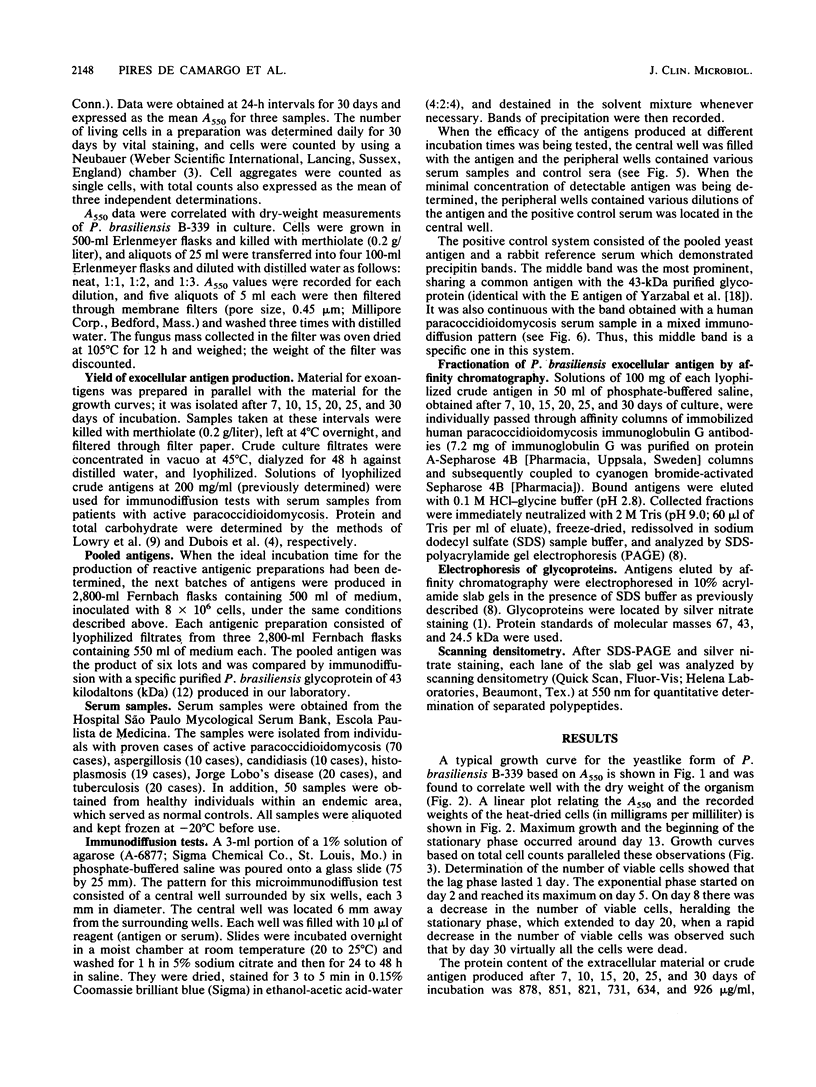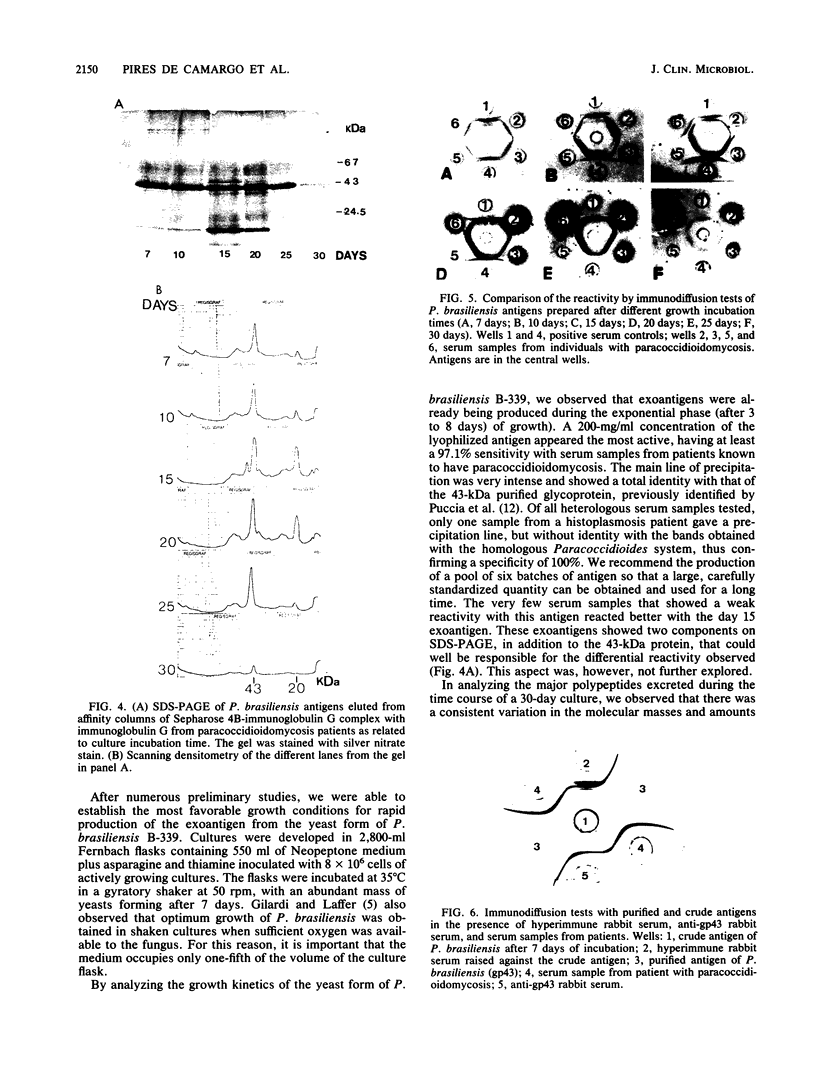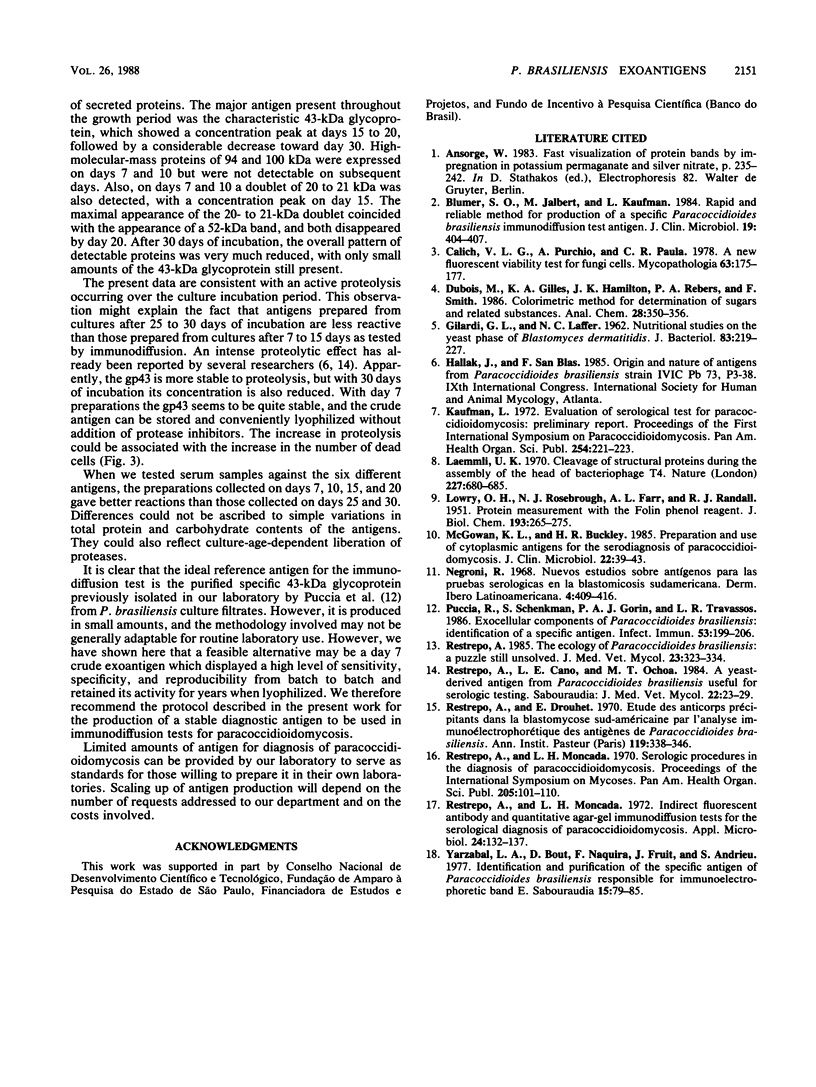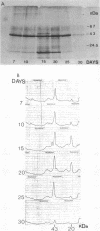Abstract
Growth curves of the yeast form of Paracoccidioides brasiliensis B-339 based on total and viable cell counts were determined. Crude culture filtrate antigens were obtained after 7, 10, 15, 20, 25, and 30 days of incubation. Different patterns of proteins were obtained by affinity chromatography on Sepharose 4B-immunoglobulin G complex made with immunoglobulin G from patients with paracoccidioidomycosis, with subsequent analyses by sodium dodecyl sulfate-polyacrylamide gel electrophoresis and scanning densitometry. Three major proteins were excreted during the time course of a 30-day culture: a doublet at 20 to 21 kilodaltons (kDa) and molecules of 43 and 52 kDa. The 43-kDa antigen was present throughout the growth period, and its level reached a peak on days 15 to 20 and then decreased considerably toward day 30. The antigenic preparations collected on days 7, 10, 15, and 20 gave better reactions in immunodiffusion tests than those collected on days 25 and 30. The 7-day exoantigen gave a sensitivity of 97.1% and specificity of 100% on immunodiffusion. The main line of precipitation had a very high intensity, showing a total identity with that of a previously purified glycoprotein of 43 kDa. A 7-day crude exoantigen displayed a high level of sensitivity and specificity, being reproducible from batch to batch and retaining its activity for years when kept lyophilized. A protocol is recommended for the production of a stable diagnostic antigen to be used in immunodiffusion tests for paracoccidioidomycosis.
Full text
PDF




Images in this article
Selected References
These references are in PubMed. This may not be the complete list of references from this article.
- Blumer S. O., Jalbert M., Kaufman L. Rapid and reliable method for production of a specific Paracoccidioides brasiliensis immunodiffusion test antigen. J Clin Microbiol. 1984 Mar;19(3):404–407. doi: 10.1128/jcm.19.3.404-407.1984. [DOI] [PMC free article] [PubMed] [Google Scholar]
- GILARDI G. L., LAFFER N. C. Nutritional studies on the yeast phase of Blastomyces dermatitidis and B. brasiliensis. J Bacteriol. 1962 Feb;83:219–227. doi: 10.1128/jb.83.2.219-227.1962. [DOI] [PMC free article] [PubMed] [Google Scholar]
- LOWRY O. H., ROSEBROUGH N. J., FARR A. L., RANDALL R. J. Protein measurement with the Folin phenol reagent. J Biol Chem. 1951 Nov;193(1):265–275. [PubMed] [Google Scholar]
- Laemmli U. K. Cleavage of structural proteins during the assembly of the head of bacteriophage T4. Nature. 1970 Aug 15;227(5259):680–685. doi: 10.1038/227680a0. [DOI] [PubMed] [Google Scholar]
- McGowan K. L., Buckley H. R. Preparation and use of cytoplasmic antigens for the serodiagnosis of paracoccidioidomycosis. J Clin Microbiol. 1985 Jul;22(1):39–43. doi: 10.1128/jcm.22.1.39-43.1985. [DOI] [PMC free article] [PubMed] [Google Scholar]
- Puccia R., Schenkman S., Gorin P. A., Travassos L. R. Exocellular components of Paracoccidioides brasiliensis: identification of a specific antigen. Infect Immun. 1986 Jul;53(1):199–206. doi: 10.1128/iai.53.1.199-206.1986. [DOI] [PMC free article] [PubMed] [Google Scholar]
- Restrepo A., Drouhet E. Etude des anticorps précipitants dans la blastomycose sud-américaine par l'analyse immunoélectrophorétique des antigènes de paracoccidioides brasiliensis. Ann Inst Pasteur (Paris) 1970 Sep;119(3):338–346. [PubMed] [Google Scholar]
- Restrepo A., Moncada L. H. Indirect fluorescent-antibody and quantitative agar-gel immunodiffusion tests for the serological diagnosis of paracoccidioidomycosis. Appl Microbiol. 1972 Jul;24(1):132–137. doi: 10.1128/am.24.1.132-137.1972. [DOI] [PMC free article] [PubMed] [Google Scholar]
- Restrepo A. The ecology of Paracoccidioides brasiliensis: a puzzle still unsolved. Sabouraudia. 1985 Oct;23(5):323–334. [PubMed] [Google Scholar]
- Yarzabal L. A., Bout D., Naquira F., Fruit J., Andrieu S. Identification and purification of the specific antigen of Paracoccidioides brasiliensis responsible for immunoelectrophoretic band E. Sabouraudia. 1977 Mar;15(1):79–85. [PubMed] [Google Scholar]





